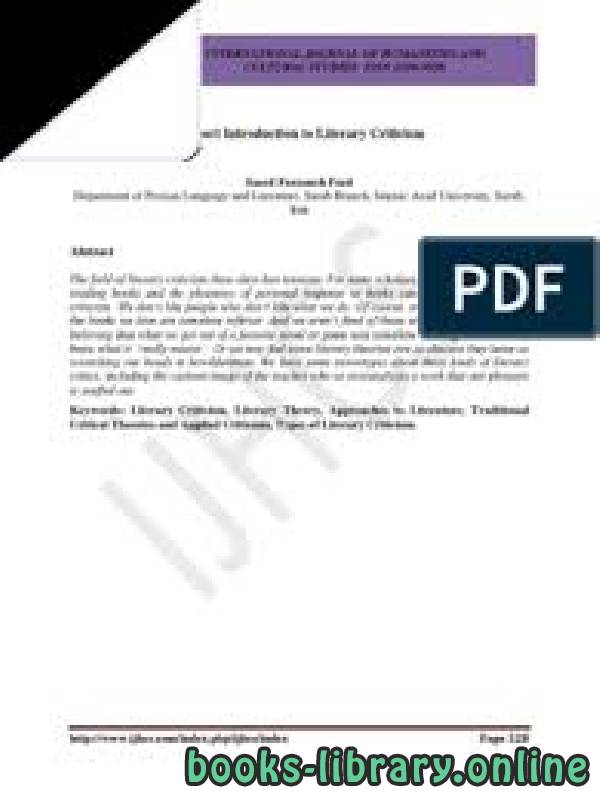📘 قراءة كتاب A Short Introduction to Literary Criticism أونلاين


هذا القسم يحتوي علي كل ما يتعلق بالنقد الأدبي.
النقد الأدبي دراسة ونقاش وتقييم وتفسير الأدب. يعتمد النقد الأدبي الحديث غالبا على النظرية الأدبية وهي النقاش الفلسفي لطرق النقد الأدبي وأهدافه، ورغم العلاقة بينهما فإن النقاد الأدبيين ليسوا دوما منظرين.
هو فن تفسير الأعمال الأدبية، وهو محاولة منضبطة يشترك فيها ذوق الناقد وفكره ،للكشف عن مواطن الجمال أو القبح في الأعمال الأدبية. والأدب سابق للنقد في الظهور، ولولا وجود الأدب لما كان هناك نقد أدبي لأن قواعده مستقاة ومستنتجة من دراسة الأدب ،إن الناقد ينظر في النصوص الأد بية شعرية كانت أو نثرية ثم يأخذ الكشف عن مواطن الجمال والقبح فيها معللاً مايقولة ومحاولاً أن يثير في نفوسنا شعور بأن ما يقوله صحيح وأقصى ما يطمح إليه النقد الأدبي، لأنه لن يستطيع أبداً أن يقدم لنا برهاناً علميا يقيناً. ولذا لا يوجد عندنا نقد أدبي صائب وآخر خاطئ وإنما يوجد نقد أدبي أكثر قدرة على تأويل العمل الفني وتفسيره من غيره واختلاف مناهج النقد معناه اختلاف في وجهات النظر.والذوق هو المرجع الأول في الحكم على الأدب والفنون لأنه أقرب الموازين والمقاييس إلى طبيعتها، ولكن الذوق الجدير بالاعتبار هو الذوق المصقول لذوق الناقد الذي يستطيع أن يكبح جماح هواه الخاص الذي قد يجافي في الصواب ،الخبير بالأدب الذي راضه ومارسه، وتخصص في فهمه ودرس أساليب الأدباء ومنح القدرة على فهم أسرارهم والنفوذ إلى دخائلهم وادراك مشاعرهم وسبر عواطفهم، بفهمه العميق وحسه المرهف وكثرة تجاربه الأدبية لذلك لابد أن يتمتع الناقدبعدة صفات منها:
قدر وافر من المعرفة والثقافة
البصر الثاقب الذي يكون خير معين له على إصدار الحكم الصائب
فالأدب ونقده ذوق وفن ،قبل أن يكون معرفة وعلما وان كانت المعرفة تعين صاحب الحس المرهف والذوق السليم والطبع .
Literary criticism (or literary studies) is the study, evaluation, and interpretation of literature. Modern literary criticism is often influenced by literary theory, which is the philosophical discussion of literature's goals and methods. Though the two activities are closely related, literary critics are not always, and have not always been, theorists.
Whether or not literary criticism should be considered a separate field of inquiry from literary theory, or conversely from book reviewing, is a matter of some controversy. For example, the Johns Hopkins Guide to Literary Theory and Criticism[1] draws no distinction between literary theory and literary criticism, and almost always uses the terms together to describe the same concept. Some critics consider literary criticism a practical application of literary theory, because criticism always deals directly with particular literary works, while theory may be more general or abstract.
Literary criticism is often published in essay or book form. Academic literary critics teach in literature departments and publish in academic journals, and more popular critics publish their reviews in broadly circulating periodicals such as The Times Literary Supplement, The New York Times Book Review, The New York Review of Books, the London Review of Books, the Dublin Review of Books, The Nation, Bookforum, and The New Yorker.
Contents
1 History
1.1 Classical and medieval criticism
1.2 Renaissance criticism
1.3 Enlightenment criticism
1.4 19th-century Romantic criticism
1.5 The New Criticism
1.6 Theory
1.7 History of the book
1.8 Current state
2 Value of academic criticism
3 Key texts
3.1 The Classical and medieval periods
3.2 The Renaissance period
3.3 The Enlightenment period
3.4 The 19th century
3.5 The 20th century
Classical and medieval criticism
Literary criticism is thought to have existed as long as literature. In the 4th century BC Aristotle wrote the Poetics, a typology and description of literary forms with many specific criticisms of contemporary works of art. Poetics developed for the first time the concepts of mimesis and catharsis, which are still crucial in literary studies. Plato's attacks on poetry as imitative, secondary, and false were formative as well. The Sanskrit Natya Shastra includes literary criticism on ancient Indian literature and Sanskrit drama.
Later classical and medieval criticism often focused on religious texts, and the several long religious traditions of hermeneutics and textual exegesis have had a profound influence on the study of secular texts. This was particularly the case for the literary traditions of the three Abrahamic religions: Jewish literature, Christian literature and Islamic literature.
Literary criticism was also employed in other forms of medieval Arabic literature and Arabic poetry from the 9th century, notably by Al-Jahiz in his al-Bayan wa-'l-tabyin and al-Hayawan, and by Abdullah ibn al-Mu'tazz in his Kitab al-Badi.
Renaissance criticism
The literary criticism of the Renaissance developed classical ideas of unity of form and content into literary neoclassicism, proclaiming literature as central to culture, entrusting the poet and the author with preservation of a long literary tradition. The birth of Renaissance criticism was in 1498, with the recovery of classic texts, most notably, Giorgio Valla's Latin translation of Aristotle's Poetics. The work of Aristotle, especially Poetics, was the most important influence upon literary criticism until the late eighteenth century. Lodovico Castelvetro was one of the most influential Renaissance critics who wrote commentaries on Aristotle's Poetics in 1570.
Enlightenment criticism
In the Enlightenment period (1700s to 1800s), literary criticism became more popular. During this time period literacy rates started to rise in the public; no longer was reading exclusive for the wealthy or scholarly. With the rise of the literate public and swiftness of printing, criticism arose too. Reading was no longer viewed solely as educational or as a sacred source of religion; it was a form of entertainment. Literary criticism was influenced by the values and stylistic writing, including clear, bold, precise writing and the more controversial criteria of the author's religious beliefs. These critical reviews were published in many magazines, newspapers, and journals. Many works of Jonathan Swift were criticized including his book Gulliver's Travels, which one critic described as "the detestable story of the Yahoos".
19th-century Romantic criticism
The British Romantic movement of the early nineteenth century introduced new aesthetic ideas to literary studies, including the idea that the object of literature need not always be beautiful, noble, or perfect, but that literature itself could elevate a common subject to the level of the sublime. German Romanticism, which followed closely after the late development of German classicism, emphasized an aesthetic of fragmentation that can appear startlingly modern to the reader of English literature, and valued Witz – that is, "wit" or "humor" of a certain sort – more highly than the serious Anglophone Romanticism. The late nineteenth century brought renown to authors known more for their literary criticism than for their own literary work, such as Matthew Arnold.
The New Criticism
However important all of these aesthetic movements were as antecedents, current ideas about literary criticism derive almost entirely from the new direction taken in the early twentieth century. Early in the century the school of criticism known as Russian Formalism, and slightly later the New Criticism in Britain and in the United States, came to dominate the study and discussion of literature, in the English-speaking world. Both schools emphasized the close reading of texts, elevating it far above generalizing discussion and speculation about either authorial intention (to say nothing of the author's psychology or biography, which became almost taboo subjects) or reader response. This emphasis on form and precise attention to "the words themselves" has persisted, after the decline of these critical doctrines themselves.
Theory
In 1957 Northrop Frye published the influential Anatomy of Criticism. In his works Frye noted that some critics tend to embrace an ideology, and to judge literary pieces on the basis of their adherence to such ideology. This has been a highly influential viewpoint among modern conservative thinkers. E. Michael Jones, for example, argues in his Degenerate Moderns that Stanley Fish was influenced by his adulterous affairs to reject classic literature that condemned adultery.[5] Jürgen Habermas in Erkenntnis und Interesse [1968] (Knowledge and Human Interests), described literary critical theory in literary studies as a form of hermeneutics: knowledge via interpretation to understand the meaning of human texts and symbolic expressions—including the interpretation of texts which themselves interpret other texts.
In the British and American literary establishment, the New Criticism was more or less dominant until the late 1960s. Around that time Anglo-American university literature departments began to witness a rise of a more explicitly philosophical literary theory, influenced by structuralism, then post-structuralism, and other kinds of Continental philosophy. It continued until the mid-1980s, when interest in "theory" peaked. Many later critics, though undoubtedly still influenced by theoretical work, have been comfortable simply interpreting literature rather than writing explicitly about methodology and philosophical presumptions.
History of the book
Related to other forms of literary criticism, the history of the book is a field of interdisciplinary inquiry drawing on the methods of bibliography, cultural history, history of literature, and media theory. Principally concerned with the production, circulation, and reception of texts and their material forms, book history seeks to connect forms of textuality with their material aspects.
Among the issues within the history of literature with which book history can be seen to intersect are: the development of authorship as a profession, the formation of reading audiences, the constraints of censorship and copyright, and the economics of literary form.
Current state
Today, interest in literary theory and continental philosophy coexists in university literature departments with a more conservative literary criticism of which the New Critics would probably have approved. Disagreements over the goals and methods of literary criticism, which characterized both sides taken by critics during the "rise" of theory, have declined. Many critics feel that they now have a great plurality of methods and approaches from which to choose.[citation needed]
Some critics work largely with theoretical texts, while others read traditional literature; interest in the literary canon is still great, but many critics are also interested in minority and women's literature, as elaborated on by certain academic journals such as Contemporary Women's Writing,[6] while some critics influenced by cultural studies read popular texts like comic books or pulp/genre fiction. Ecocritics have drawn connections between literature and the natural sciences. Darwinian literary studies studies literature in the context of evolutionary influences on human nature. And postcritique has sought to develop new ways of reading and responding to literary texts that go beyond the interpretive methods of critique. Many literary critics also work in film criticism or media studies. Some write intellectual history; others bring the results and methods of social history to bear on reading literature.[citation needed]
Value of academic criticism
The value of extensive literary analysis has been questioned by several prominent artists. Vladimir Nabokov once wrote that good readers do not read books, and particularly those which are considered to be literary masterpieces, "for the academic purpose of indulging in generalizations". Terry Eagleton attributes an unsung stature to literary critics and to criticism in academia. He believes that critics are not so well-known and praised, to his disappointment, and that literary criticism is declining in its value because of the manner the general audience is directing it towards that underappreciated state. At a 1986 Copenhagen conference of James Joyce scholars, Stephen J. Joyce (the modernist writer's grandson) said, "If my grandfather was here, he would have died laughing ... Dubliners and A Portrait of the Artist as a Young Man can be picked up, read, and enjoyed by virtually anybody without scholarly guides, theories, and intricate explanations, as can Ulysses, if you forget about all the hue and cry." He later questioned whether anything has been added to the legacy of Joyce's art by the 261 books of literary criticism stored in the Library of Congress
A Short Introduction to Literary Criticism Saeed Farzaneh Fard Department of Persian Language and Literature, Sarab Branch, Islamic Azad University, Sarab,
Abstract The field of literary criticism these days has tensions. For some scholars, the sheer enjoyment of reading books and the pleasures of personal response to books can be ruined by literary criticism. We don’t like people who don’t like what we do. Of course, or who make us feel that the books we love are somehow inferior. And we aren’t fond of those who seek to bully us into believing that what we got out of a favorite novel or poem was somehow “wrong” and that they know what it “really means”. Or we may feel some literary theories are so obscure they leave us scratching our heads in bewilderment. We have some stereotypes about these kinds of literary critics, including the cartoon image of the teacher who so overanalyzes a work that our pleasure is snuffed out. Keywords: Literary Criticism, Literary Theory, Approaches to Literature, Traditional Critical Theories and Applied Criticism, Types of Literary Criticism.
1. Introduction
For centuries literary criticism was considered as an art of writing poetry; it was an advice to the poet rather than the reader. Literary criticism has been applied since the seventeenth century to the description, justification, analysis, or judgments of works arts. Criticism in modern times is classified in different ways. M.H. Abrams in The Mirror and the Lamp talks about four different critical theories: When the critic views art in terms of the universe or what is imitated, he is using the mimetic theory. When the emphasis is shifted to the reader, and the critic views art in terms of its effect on the audience, he is using a pragmatic theory that was dominant up to the end of the eighteenth century. But in the nineteenth century the emphasis shifted to the poet, and poetry became „a spontaneous overflow of powerful feeling‟ of the poet. In this case a work of art is essentially the internal made external. Therefore, when a critic views art in terms of the artist, he is using the expressive theory. In the 20th century, the emphasis shifted to the work of art, especially under the influence of the New Criticism. When the critic views art basically in its own terms, seeing the work as a self-contained entity, he is using the objective theory.
Literary criticism
literary criticism summary
literary criticism theories
literary criticism pdf
literary criticism approaches
traditional literary criticism
introduction to literary theory
literary theories summary
one literary theory
Literary
literary devices
literary traduction
literally meaning
criticism
types of criticism
criticism in literature
criticism synonym
criticism traduction
criticism quotes
criticism en francais
criticism plural
criticise
literary theory
literary criticism summary
introduction to literary theory
literary criticism pdf
one literary theory
literary theories summary
literary criticism approaches
traditional literary criticism
سنة النشر : 2016م / 1437هـ .
حجم الكتاب عند التحميل : 0.5MB .
نوع الكتاب : pdf.
عداد القراءة:
اذا اعجبك الكتاب فضلاً اضغط على أعجبني و يمكنك تحميله من هنا:

شكرًا لمساهمتكم
شكراً لمساهمتكم معنا في الإرتقاء بمستوى المكتبة ، يمكنكم االتبليغ عن اخطاء او سوء اختيار للكتب وتصنيفها ومحتواها ، أو كتاب يُمنع نشره ، او محمي بحقوق طبع ونشر ، فضلاً قم بالتبليغ عن الكتاب المُخالف:
 قبل تحميل الكتاب ..
قبل تحميل الكتاب ..
يجب ان يتوفر لديكم برنامج تشغيل وقراءة ملفات pdf
يمكن تحميلة من هنا 'http://get.adobe.com/reader/'


 منصّة المكتبة
منصّة المكتبة 